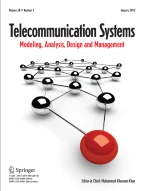Abstract
In this letter, we consider a novel problem of blind source separation from observed magnitude-only measurements of their convolutive mixture in different communication systems. The problem setups correspond to a blind receiver architecture that either does not have phase information in the measurements or has excessive phase noise that cannot be easily recovered. We have formulated the problem as a matrix recovery problem by using the lifting technique and proposed a convex programming-based solution for joint recovery of the unknown channel and source signals. We have implemented the proposed solution using the alternating direction method of multipliers (ADMM). We have plotted a phase transition diagram for random Gaussian subspaces that shows, for s source signals each of length n and channel of length k, the minimum measurements required for exact recovery are \(m \ge 1.19 (sn+k) \log ^{2}m\) that is in accord with our theoretical result. We have also plotted a phase transition diagram for the case where the channel delays matrix is deterministic (consisting of the first k columns of the identity matrix) that shows the minimum measurements required for exact recovery are \(m \ge 2.86 (sn+k) \log ^{2}m\) which are higher than random subspaces.
Explore related subjects
Discover the latest articles, news and stories from top researchers in related subjects.References
Saad, W., Bennis, M., & Chen, M. (2020). A vision of 6g wireless systems: Applications, trends, technologies, and open research problems. IEEE Network, 34(3), 134–142.
Tse, D., & Viswanath, P. (2005). Fundamentals of wireless communication. Cambridge: Cambridge University Press.
Beg, M., Clark, A. (1990) “Training of a channel estimator for frequency-selective fading channels,” in 1989 Fifth International Conference on Radio Receivers and Associated Systems, pp. 25–29.
Tugnait, J. (1994). Blind estimation of digital communication channel impulse response. IEEE Transactions on Communications, 42(234), 1606–1616.
Baykal, B. (2004). Blind channel estimation via combining autocorrelation and blind phase estimation. IEEE Transactions on Circuits and Systems I: Regular Papers, 51(6), 1125–1131.
Ding, Z., Lei, X., Karagiannidis, G. K., Schober, R., Yuan, J., & Bhargava, V. K. (2017). “A survey on non-orthogonal multiple access for 5g networks: Research challenges and future trends,” CoRR, vol. abs/1706.05347, [Online]. Available: http://arxiv.org/abs/1706.05347
Lin, B., Ye, W., Tang, X., & Ghassemlooy, Z. (2017). Experimental demonstration of bidirectional noma-ofdma visible light communications. Optical Express, 25(4), 4348–4355.
Candès, E., Strohmer, T., & Voroninski, V. (2011). Phaselift: Exact and stable signal recovery from magnitude measurements via convex programming. Communications on Pure and Applied Mathematics, 66, 1241.
Candès, E., Li, X., & Soltanolkotabi, M. (2014). Phase retrieval via wirtinger flow: Theory and algorithms. IEEE Transactions on Information Theory, 61, 1985.
Goldstein, T., & Studer, C. (2016). Phasemax: Convex phase retrieval via basis pursuit. IEEE Transactions on Information Theory, 64, 2675.
Pinilla, S., Mishra, K. V., Shevkunov, I., Soltanalian, M., Katkovnik, V., & Egiazarian, K. (2022). “Unfolding-aided bootstrapped phase retrieval in optical imaging,” arXiv
Chopard, A., Tsiplakova, E., & Balbekin, N. (2022). Single-scan multiplane phase retrieval with a radiation of terahertz quantum cascade laser. Applied Physics B, 128, 1–9.
Ahmed, A., Recht, B., & Romber, J. (2013). Blind deconvolution using convex programming. IEEE Transactions on Information Theory, 60(3), 1711–1732.
J. Romberg, N. Tina, and K. Sabra, “Multichannel blind deconvolution using low rank recovery,” Proc. SPIE 8750, Independent Component Analyses, Compressive Sampling, Wavelets, Neural Net, Biosystems, and Nanoengineering XI, vol. 8750, no. 1, pp. 1–4, 2013.
Asif, M. S., Mantzel, W., & Romberg, J. (2009). “Random channel coding and blind deconvolution,” Communication, Control, and Computing, 2009. Allerton 2009. 47th Annual Allerton Conference on, pp. 1021–1025
Ling, S., & Strohmer, T. (2015). “Blind deconvolution meets blind demixing,” Forty-Seventh Annual Allerton Conference Allerton House (pp. 1–50). Illinois, USn: UIUC.
Bahmani, S., & Romberg, J. (2015). Lifting for blind deconvolution in random mask imaging: Identifiability and convex relaxation. Society for Industrial and Applied Mathematics, 8(4), 2203–2238.
Ahmed, A. (2020). Blind deconvolution using modulated inputs. IEEE Transactions on Signal Processing, 68, 374–387.
Ahmed, A., Aghasi, A., & Hand, P. (2018). Blind deconvolutional phase retrieval via convex programming. Advances in Neural Information Processing Systems, 31, 1030.
Ahmed, A., Aghasi, A., & Hand, P. (2019). Simultaneous phase retrieval and blind deconvolution via convex programming. Journal of Machine Learning Research, 61, 5413.
Pinilla, S., Mishra, K. V., & Sadler B. M. (2021). “Non-convex recovery from phaseless low-resolution blind deconvolution measurements using noisy masked patterns,” http://arxiv.org/abs2111.13670
Funding
This work was supported by the Higher Education Commission, Pakistan under the National Research Program for Universities, Project 6856.
Author information
Authors and Affiliations
Corresponding author
Ethics declarations
Conflict of interest
On behalf of all authors, corresponding author states that there is no conflict of interest.
Additional information
Publisher's Note
Springer Nature remains neutral with regard to jurisdictional claims in published maps and institutional affiliations.
Rights and permissions
About this article
Cite this article
Hameed, H., Ahmed, A. & Fayyaz, U.U. Single-channel phaseless blind source separation. Telecommun Syst 80, 469–475 (2022). https://doi.org/10.1007/s11235-022-00906-1
Accepted:
Published:
Issue Date:
DOI: https://doi.org/10.1007/s11235-022-00906-1
